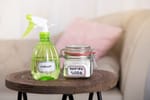People are growing more fearful and concerned about the toxicity of the various wall treatments. From paint to vinyl, the materials used to cover walls can come with warnings about toxicity.
Luckily, there are several eco-friendly wall treatment options.
When it comes to the safety of the environment inside your home, nobody is going to care more than you do.
So, it’s in your best interest to research those environmentally-friendly alternatives.
In this article, I will cover 5 Eco-Friendly Wall Treatments that you should consider.
Let’s check them out…
1)) Fabrics
One of the latest trends in wall treatments is to cover a wall (or walls) with fabric. However, if you use a spray adhesive and synthetic material, it's hardly environmentally friendly.
If you're looking for a way to cover your walls with fabric without the chemicals, consider these points…
- Natural fabrics and materials like cotton, wool, linen, and hemp make fine wall coverings, and they are made from natural fibers.
- Look for fabrics that are dyed with natural pigments, such as vegetable dyes.
- To adhere your fabric to the wall, you can use liquid starch or mix corn starch with water in a 1 to 2 ratio (1 part corn starch to 2 parts water). This is more eco-friendly than chemical adhesives. Another alternative is to hang the fabric and skip the adhesives altogether.
2)) Textured Tiles
There is an innovative wall treatment out there that's eco-friendly and adds a three-dimensional texture to your walls.
Tiles made from bamboo pulp can be purchased in various textures and patterns, and you can paint them in any color you like (they usually come in white).
3)) Eco-Friendly Paint
Mainstream manufacturers have figured out that consumers are looking for environmentally friendly paint.
It's not hard to find paint without toxic chemicals such as VOCs, or volatile organic compounds in your local store.
You can even get powdered paint from natural pigments made with milk protein, and mix it with liquid as needed.
4)) Natural Plaster
The ancient process of adobe and other natural plasters has been revisited.
You can purchase all-natural products made from materials such as clay, sand, and cellulose that you can apply to your walls and add texture as you, please.
You can even press leaf images into the wet plaster on the wall, or mix shells or straw into the plaster before applying.
You’re only limited by your imagination.
5)) Bamboo
One of the most sustainable woods available, bamboo can be used for a number of wall treatments.
Wallpaper made from bamboo, textured or flat is available, as are panels made from bamboo.
You can find dark and light finishes in bamboo, and can even mix them for a striped look.
Conclusion
Choosing eco-friendly wall materials is one step towards decreasing the toxicity inside your home.
While I’ve provided you with 5 Eco-Friendly Wall Treatment ideas, keep in mind that there are more options available such as Cork, Wallpaper, Wood Veneer, Green Living Walls,
Recycled Paper Tiles, and so on…
I advise you to really take your time by researching as many of the available options as possible to compare things such as the pros and cons, the cost involved, and what’ll match your décor.
Because the last thing you want to do is go through the trouble and expense of installing wall treatments you may not like in the end.
It’s nearly impossible to totally control how much toxic material you’re exposed to…
However, you can and should do everything within your power to minimize that exposure for yourself and your loved ones.
Have fun with the process of selecting Eco-friendly wall treatments!
Download Our Free E-book!







